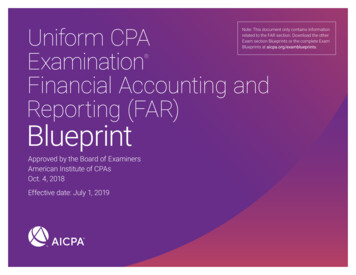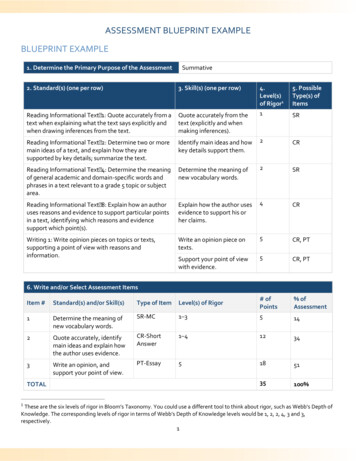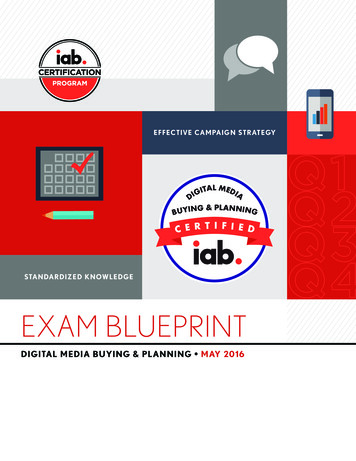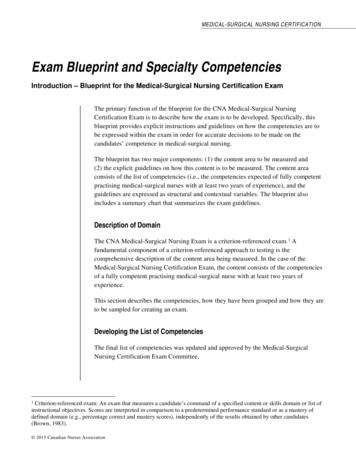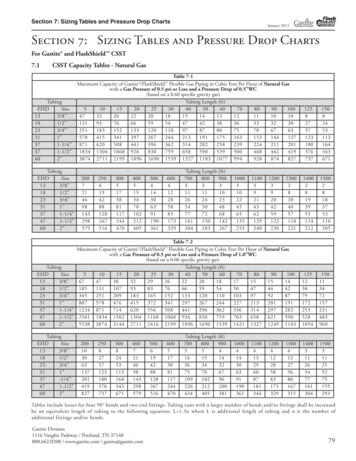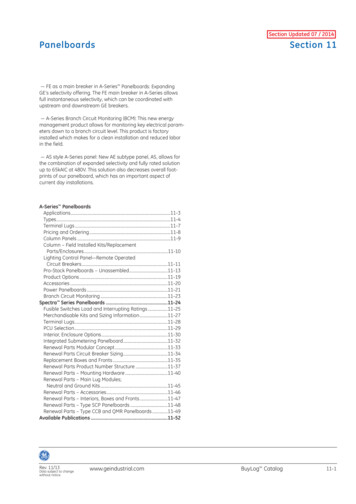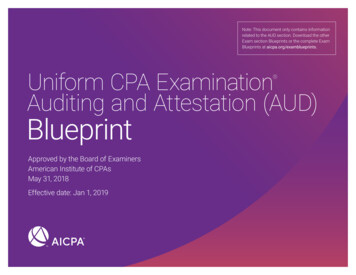
Transcription
Note: This document only contains informationrelated to the AUD section. Download the otherExam section Blueprints or the complete ExamBlueprints at aicpa.org/examblueprints.Uniform CPA ExaminationAuditing and Attestation (AUD) BlueprintApproved by the Board of ExaminersAmerican Institute of CPAsMay 31, 2018Effective date: Jan 1, 2019Uniform CPA Examination Blueprintsi
Uniform CPA Examination BlueprintsTable of contents2AUD1Introduction: Uniform CPA Examination BlueprintsFAR1Auditing and Attestation (AUD)AUD2Section introductionAUD6Summary blueprintFinancial Accounting and Reporting (FAR)FAR2Section introductionFAR6Summary blueprintFAR7Area I — Conceptual Framework, Standard-Settingand Financial ReportingAUD7Area I — Ethics, Professional Responsibilitiesand General PrinciplesFAR13Area II — Select Financial Statement AccountsFAR19Area III — Select TransactionsAUD12Area II — Assessing Risk and Developinga Planned ResponseFAR24Area IV — State and Local GovernmentsAUD18Area III — Performing Further Proceduresand Obtaining EvidenceAUD23BEC1Area IV — Forming Conclusions and ReportingBusiness Environment and Concepts (BEC)REG1Regulation (REG)REG2Section introductionREG5Summary blueprintREG6Area I — Ethics, Professional Responsibilitiesand Federal Tax ProceduresBEC2Section introductionREG8Area II — Business LawBEC6Summary blueprintREG12Area III — Federal Taxation of Property TransactionsBEC7Area I — Corporate GovernanceREG15Area IV — Federal Taxation of IndividualsBEC9Area II — Economic Concepts and AnalysisREG18Area V — Federal Taxation of EntitiesBEC11Area III — Financial ManagementBEC13Area IV — Information TechnologyBEC15Area V — Operations ManagementUniform CPA Examination Blueprints1
IntroductionUniform CPA Examination BlueprintsThe Uniform CPA Examination (the Exam) is comprised of four sections, eachfour hours long: Auditing and Attestation (AUD), Business Environment andConcepts (BEC), Financial Accounting and Reporting (FAR) and Regulation (REG).The AICPA has adopted a skill framework for the Exam based on the revisedBloom’s Taxonomy of Educational Objectives. Bloom’s Taxonomy classifies acontinuum of skills that students can be expected to learn and demonstrate.The table below presents the design of the Exam by section, section time andquestion type.Approximately 600 representative tasks that are critical to a newly licensedCPA’s role in protecting the public interest have been identified. Therepresentative tasks combine both the applicable content knowledge and skillsrequired in the context of the work of a newly licensed CPA. Based on the natureof a task, one of four skill levels, derived from the revised Bloom’s Taxonomy,was assigned to each of the tasks, as dquestions (MCQs) simulations (TBSs)WrittencommunicationAUD4 hours728—BEC4 hours6243FAR4 hours668—REG4 hours768—The table below presents the scoring weight of multiple-choice questions(MCQs), task-based simulations (TBSs) and written communication for eachExam section.Skill levelsEvaluationThe examination or assessment of problems, anduse of judgment to draw conclusions.AnalysisThe examination and study of the interrelationshipsof separate areas in order to identify causes and findevidence to support inferences.ApplicationThe use or demonstration of knowledge, conceptsor techniques.Remembering andUnderstandingThe perception and comprehension of thesignificance of an area utilizing knowledge gained.Score weightingSectionMultiple-choicequestions (MCQs)Task-basedsimulations FAR50%50%—REG50%50%—Uniform CPA Examination Blueprints2
IntroductionUniform CPA Examination Blueprints (continued)The skill levels to be assessed on each section of the Exam are included in thetable below.SectionRemembering %35–45%25–35%—*Includes written communicationThe purpose of the blueprint is to: Document the minimum level of knowledge and skills necessary for initiallicensure. Assist candidates in preparing for the Exam by outlining the knowledge andskills that may be tested. Apprise educators about the knowledge and skills candidates will need tofunction as newly licensed CPAs. Guide the development of Exam questions.The tasks in the blueprints are representative and are not intended to be (norshould they be viewed as) an all-inclusive list of tasks that may be tested onthe Exam. It also should be noted that the number of tasks associated with aparticular content group or topic is not indicative of the extent such contentgroup, topic or related skill level will be assessed on the Exam.Each section of the Exam has a section introduction and a correspondingsection blueprint. The section introduction outlines the scope of the section, the contentorganization and tasks, the content allocation, the overview of content areas,the skill allocation and a listing of the section’s applicable reference literature. The section blueprint outlines the content to be tested, the associated skilllevel to be tested and the representative tasks a newly licensed CPA wouldneed to perform to be considered competent. The blueprints are organized bycontent AREA, content GROUP, and content TOPIC. Each topic includes oneor more representative TASKS that a newly licensed CPA may be expected tocomplete.Revised taxonomy see Anderson, L.W. (Ed.), Krathwohl, D.R. (Ed.), Airasian, P.W., Cruikshank, K.A., Mayer, R.E., Pintrich, P.R., Raths, J., & Wittrock, M.C. (2001). A taxonomy for learning, teaching, and assessing: A revision of Bloom’s Taxonomy ofEducational Objectives (Complete Edition). New York: Longman. For original taxonomy see Bloom, B.S. (Ed.), Engelhart, M.D., Furst, E.J., Hill, W.H., & Krathwohl, D.R. (1956). Taxonomy of educational objectives: The classification of educationalgoals. Handbook 1: Cognitive domain. New York: David McKay.Uniform CPA Examination Blueprints3
Uniform CPA ExaminationAuditing and Attestation (AUD)BlueprintUniform CPA Examination Blueprints: Auditing and Attestation (AUD)AUD1
Section introductionAuditing and AttestationThe Auditing and Attestation (AUD) section of the Uniform CPA Examination(the Exam) tests the knowledge and skills that a newly licensed CPA mustdemonstrate when performing:Tasks included in the AUD section blueprint may, and typically do, relate tomultiple engagement types. For example, tasks related to Analytical Procedures(included under Area III, Group C, Topic 1) may be performed during a: Audits of issuer and nonissuer entities (including governmental entities, notfor-profit entities, employee benefit plans and entities receiving federal grants) R eview engagement — as a presumptively mandatory procedure requiredunder Statement for Accounting and Review Services No. 21 (AR-C section90), or during an Attestation engagements for issuer and nonissuer entities (includingexaminations, reviews and agreed-upon procedures engagements) Preparation, compilation and review engagements for nonissuer entitiesand reviews of interim financial information for issuer entitiesNewly licensed CPAs are also required to demonstrate knowledge and skillsrelated to professional responsibilities, including ethics, independence andprofessional skepticism. Professional skepticism reflects an iterative processthat includes a questioning mind and a critical assessment of audit evidence.It is essential to the practice of public accounting and the work of newlylicensed CPAs.The engagements tested under the AUD section of the Exam are performedin accordance with professional standards and/or regulations promulgated byvarious governing bodies, including the American Institute of CPAs (AICPA),Public Company Accounting Oversight Board (PCAOB), U.S. GovernmentAccountability Office (GAO), Office of Management and Budget (OMB) and U.S.Department of Labor (DOL). A listing of standards promulgated by these bodies,and other reference materials relevant to the AUD section of the Exam, areincluded under References at the conclusion of this introduction.Content organization and tasksThe AUD section blueprint is organized by content AREA, content GROUP andcontent TOPIC. Each topic includes one or more representative TASKS thata newly licensed CPA may be expected to complete when performing audits,attestation engagements or accounting and review services engagements.Uniform CPA Examination Blueprints: Auditing and Attestation (AUD) A udit engagement – during planning, as a substantive procedure, or near theend of the engagement to assist with forming an overall conclusion on thefinancial statements.The tasks in the blueprint are representative. They are not intended to be (norshould they be viewed as) an all-inclusive list of tasks that may be tested in theAUD section of the Exam. Additionally, it should be noted that the number of tasksassociated with a particular content group or topic is not indicative of the extentsuch content group, topic or related skill level will be assessed on the Exam.Similarly, examples provided within the task statements should not be viewed asall-inclusive.Content allocationThe following table summarizes the content areas and the allocation of contenttested in the AUD section of the Exam:Content areaAllocationArea IEthics, Professional Responsibilitiesand General Principles15–25%Area IIAssessing Risk and Developing a PlannedResponse20–30%Area IIIPerforming Further Procedures andObtaining Evidence30–40%Area IVForming Conclusions and Reporting15–25%AUD2
Section introductionAuditing and Attestation (continued)Overview of content areasArea I of the AUD section blueprint covers several general topics, including thefollowing: Nature and Scope of Engagements — Understanding the nature and scope ofthe various types of audit and non-audit engagement types, including:- Audit Engagements — Financial statement audits as well as other types ofaudits a newly licensed CPA may perform, such as compliance audits, auditsof internal control integrated with an audit of financial statements and auditsof entities receiving federal grants- Non-audit Engagements – Attestation engagements (includingexaminations, reviews and agreed-upon procedures engagements),Accounting and Review Services engagements (including preparation,compilation and review engagements) and reviews of interim financialinformation Ethics, Independence and Professional Conduct — Requirements under theAICPA Code of Professional Conduct and professional and independencerequirements of the Securities and Exchange Commission (SEC), PCAOB,GAO and DOL; concepts related to professional skepticism and professionaljudgment Terms of Engagement – Preconditions for accepting an audit or non-auditengagement and the terms of engagement and engagement letter Engagement Documentation – Requirements for engagement documentationfor all types of audit and non-audit engagements Communication Requirements – Understanding the requirements forcommunicating with management, those charged with governance,component auditors and other parties Quality Control – Understanding of quality control at the firm and engagementlevelsThe remaining three areas of the AUD section blueprint (Areas II, III andIV) cover the activities that a newly licensed CPA must be able to performwhen providing professional services related to the types of engagementsUniform CPA Examination Blueprints: Auditing and Attestation (AUD)enumerated above. These sections include the activities relevant for every typeof engagement covered in the AUD section of the Exam, from the integratedaudit of an issuer, to a preparation, compilation or review for a small nonissuer,to the audit of a governmental entity. The organization of these sections followsthe typical engagement process, from planning through reporting.Area II of the AUD section blueprint covers the engagement process from initialplanning to risk assessment and designing procedures responsive to risks,including: Planning the Engagement — Understanding the engagement strategy anddeveloping a detailed engagement plan Understanding an Entity and Its Environment and Understanding InternalControls Over Financial Reporting — Developing an understanding of an entityand the risks associated with the engagement, understanding an entity’s internalcontrols, and evaluating the effect of internal controls on an engagement Assessing Risks and Planning Further Procedures — Identifying andassessing risks of misstatement due to error or fraud and developingappropriate engagement procedures, including understanding and calculatingmateriality and considering specific engagement risks, as well as incorporatingconcepts such as group audits, using the work of the internal audit functionand the work of specialistsArea III of the AUD section blueprint covers performing engagement proceduresand concluding on the sufficiency and appropriateness of evidence obtained,including performing specific types of procedures (e.g., analytical procedures,observation and inspection, recalculation and reperformance); testing theoperating effectiveness of internal controls; performing tests of compliance andagreed-upon procedures; understanding and responding to specific matters thatrequire special consideration (e.g., accounting estimates, including fair valueestimates); evaluating and responding to misstatements due to error or fraudand to internal control deficiencies; obtaining management representations;and performing procedures to identify and respond to subsequent events andsubsequently discovered facts.AUD3
Section introductionAuditing and Attestation (continued)Area IV of the AUD section blueprint covers identifying the factors that anauditor, accountant or practitioner should consider when reporting on auditing,attestation, compilation, review or compliance engagements, when perform
Uniform CPA Examination Blueprints i Uniform CPA Examination Auditing and Attestation (AUD) Blueprint Approved by the Board of Examiners American Institute of CPAs May 31, 2018 Effective date: Jan 1, 2019 Note: This document only contains information related to the AUD section. Download the other Exam section Blueprints or the complete Exam
